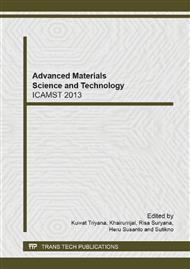[1]
J.J. Kalker, Three-dimensional Elastic Body in Rolling Contact, Kluwer Academic Publishing, Dordrecht, The Netherlands, (1990).
Google Scholar
[2]
D. Nelias, E. Antaluca, V. Boucly, Rolling of an elastic ellipsoid upon an elastic-plastic flat, ASME J. Tribol. 129 (2007) 791-800.
DOI: 10.1115/1.2768078
Google Scholar
[3]
V. Bhargava, G.T. Hahn, C.A. Rubin, C.A., An elastic plastic finite element model of rolling contact, part 1: analysis of single contacts, ASME J. Appl. Mech. 52 (1985) 67-74.
DOI: 10.1115/1.3169028
Google Scholar
[4]
Y. Jiang, B. Xu, H. Sehitoglu, Three-dimensional elastic-plastic stress analysis of rolling contact, " ASME J. Tribol. 124 (2002) 699-708.
DOI: 10.1115/1.1491978
Google Scholar
[5]
G. Popescu, G.E. Morales-Espejel, B. Wemekamp, A. Gabelli, An engineering model for three-dimensional elastic-plastic rolling contact analyses, Tribol. Trans. 49 (2006) 387-399.
DOI: 10.1080/05698190600678739
Google Scholar
[6]
D.J. Whitehouse, The Effect of Surface Topography on Wear, " in Suh and Saka (Eds. ) Fundamentals of Tribology, MIT, 1980, pp.17-52.
Google Scholar
[7]
J. Jamari, Running-in of Rolling Contacts, PhD Thesis University of Twente, The Netherlands, (2006).
Google Scholar
[8]
J. Jamari, D.J. Schipper, Deterministic repeated contact of rough surfaces, Wear 264 (2008) 349-358.
DOI: 10.1016/j.wear.2007.03.024
Google Scholar
[9]
J. Jamari, D.J. Schipper, An elastic-plastic contact model of ellipsoid bodies, Tribol. Lett. 21 (2006) 262-271.
DOI: 10.1007/s11249-006-9038-3
Google Scholar
[10]
ABAQUS 6. 11/Standard User's Manual, 2011, Dassault Systèmes Simulia Corp., USA.
Google Scholar
[11]
R. Ismail, M. Tauviqirrahman, J. Jamari, D.J. Schipper, Two-dimensional finite element analysis on running-in of elastic-plastic rolling contact, AIP Conf. Proc. 1325 (2010) 190-193.
DOI: 10.1063/1.3537894
Google Scholar
[12]
R. Ismail, M. Tauviqirrahman, J. Jamari, D.J. Schipper, The observation of the steady state phase on rolling contact using finite element analysis, AIP Conf. Proc. 1415 (2011) 136-139.
DOI: 10.1063/1.3667240
Google Scholar


